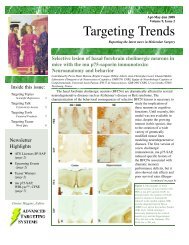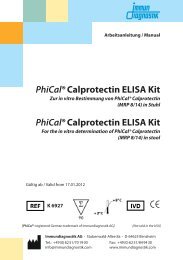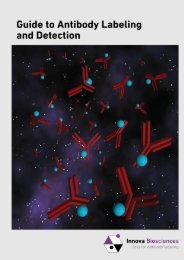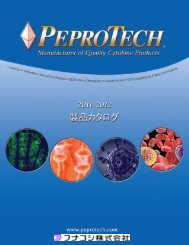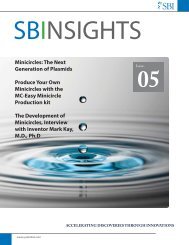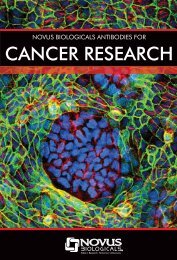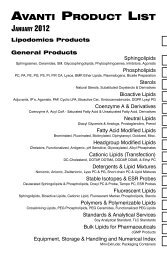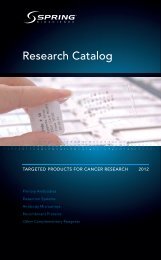Thermo Scientific Pierce Crosslinking Technical Handbook
Thermo Scientific Pierce Crosslinking Technical Handbook
Thermo Scientific Pierce Crosslinking Technical Handbook
You also want an ePaper? Increase the reach of your titles
YUMPU automatically turns print PDFs into web optimized ePapers that Google loves.
Crosslinker Reactivities<br />
Diazirines<br />
The succinimidyl-ester diazirine (SDA) reagents are a new class of<br />
crosslinkers that combine proven amine-reactive chemistry with<br />
an efficient diazirine-based photochemistry for photo-crosslinking<br />
to nearly any other functional group. Diazirine-based photocrosslinkers<br />
have better photostability than phenyl azide-based<br />
photocrosslinkers and are easily activated with long-wave UV<br />
light (330-370 nm). The SDA crosslinkers include six compounds<br />
differing in spacer arm lengths, ability to cleave the crosslinked<br />
proteins, and presence or absence of a charged group for<br />
differential membrane permeability. These SDA reagents extend<br />
the efficiency and range of interactions that can be explored by<br />
this approach.<br />
Photoactivation of diazirine with long-wave UV light (330-370 nm)<br />
creates reactive carbene intermediates. Such intermediates can<br />
form covalent bonds through addition reactions with any amino<br />
acid side-chain or peptide backbone at distances corresponding<br />
to the spacer arm lengths.<br />
The NHS-ester diazirine derivatives (SDA, LC-SDA and SDAD) lack<br />
a charged group and are membrane-permeable. This property<br />
makes them ideal for intracellular and intramembrane conjugations.<br />
By contrast, Sulfo-SDA, Sulfo-LC-SDA and Sulfo-SDAD<br />
contain negatively charged sulfonate groups that improve their<br />
water solubility and reduce cell membrane permeability, enabling<br />
their use for extracellular protein crosslinking. SDAD and<br />
Sulfo-SDAD also have a disulfide bond within the spacer that<br />
can be cleaved with reducing agents.<br />
<strong>Thermo</strong> <strong>Scientific</strong> <strong>Pierce</strong> Diazirine-based Photo-crosslinkers.<br />
Reagent Product # Reactive Groups<br />
SDA 26167 NHS, Diazirine<br />
LC-SDC 26168 NHS, Diazirine<br />
SDAD 26169 NHS, Diazirine<br />
Sulfo-SDA 26173 Sulfo-NHS, Diazirine<br />
Sulfo-LC-SDA 26174 Sulfo-NHS, Diazirine<br />
Sulfo-SDAD 26175 Sulfo-NHS, Diazirine<br />
Protein 1<br />
Protein 1<br />
NH 2<br />
O<br />
N N<br />
O<br />
N<br />
H<br />
N<br />
N 2<br />
UV 350 nm<br />
O<br />
N<br />
N<br />
O<br />
O<br />
Protein 2<br />
Protein 1<br />
H<br />
N<br />
O<br />
H<br />
Protein 2<br />
Figure 15. Mechanism of NHS-ester diazirine crosslinking.<br />
N-hydroxysuccinimide (NHS) esters react efficiently with primary amine<br />
groups (–NH 2 ) in pH 7-9 buffers to form stable amide bonds upon release<br />
of NHS. Photoactivation of diazirines with long-wave UV light (330-370 nm)<br />
creates reactive carbene intermediates. Such intermediates can form<br />
covalent bonds through addition reactions with any amino acid side chain<br />
or peptide backbone at distances corresponding to the spacer arm lengths.<br />
22<br />
For more information, or to download product instructions, visit www.thermo.com/pierce



